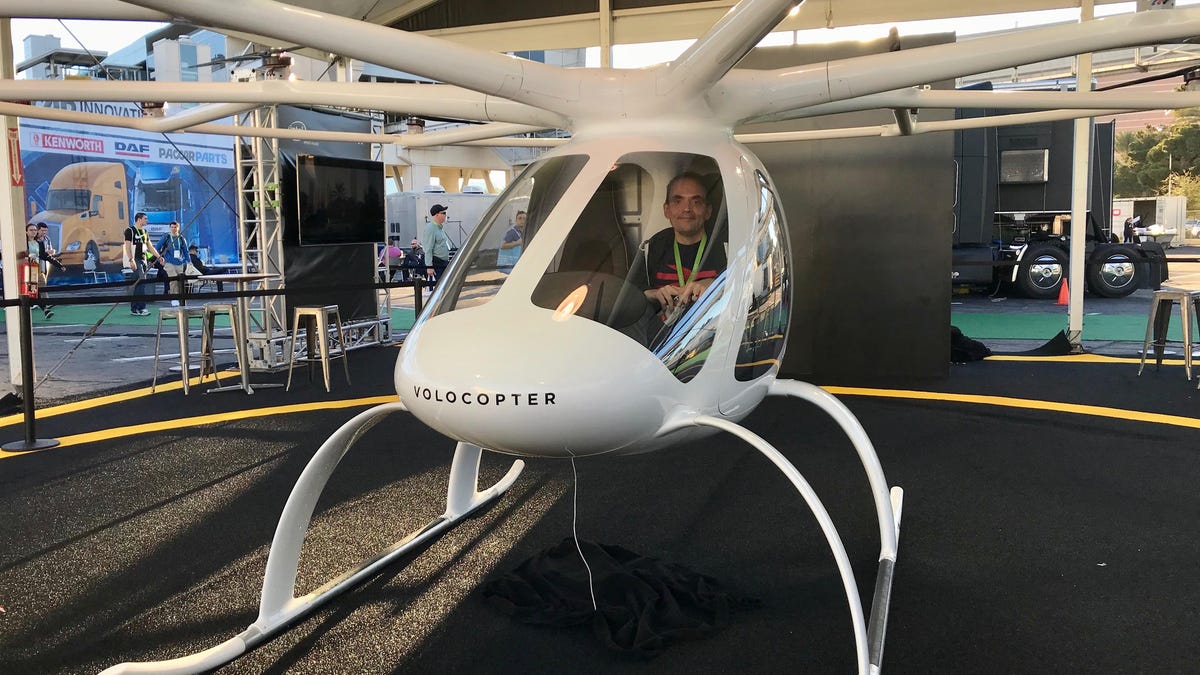Personal helicopters could be the flying cars of the future
If you've ever fantasized about soaring above the city in a personal helicopter, CES 2018 showed that the dream is getting closer to taking off.

It's a Jetsons-style dream that has been promised to urbanites for decades: Skip the congested streets by flying above them in a personal helicopter for a fast, painless commute.
In a few massive cities, most notably São Paulo, Brazil, commuting by helicopter is a reality for the wealthy. Since last year, São Paulo has even had a on-demand helicopter service operated by Voom, a project of Airbus's Silicon Valley development outpost.
For most of us that dream is still far away as we pack into buses or trains to get to work or spend too much time stuck in traffic on the freeway. But at CES two weeks ago, a few exhibitors showed how they plan to bring the idea of the air taxi to more people. You might even call them flying cars, because the idea -- hop in and take yourself where you need to go -- is about the same.
The SureFly
We first saw the SureFly at the Paris Air Show in June. Made by Ohio-based Workhouse Group, the SureFly can carry two people at 70 miles per hour and at a maximum altitude of 4,000 feet. On a full tank of gas it can fly for an hour, and there's a backup battery that gives an extra 5 minutes of flight time to get you safely back down to the ground.
With eight rotors on four arms that extend out from the cockpit, the SureFly looks almost like a giant drone, albeit one that's rather boxy. The simple controls are limited to a couple of buttons and a joystick. Workhouse says it is developing the SureFly for medical and agricultural uses, first responders as well as private consumers.
Though it will cost you more than a standard car, the sticker price is a reasonable $200,000. And if you're already readying your credit card, the SureFly won its flight certification from the Federal Aviation Administration (FAA) on Jan. 3.
The Volocopter is nothing if not streamlined.
Volocopter
One of the most exciting things to happen at CES was when the Volocopter 2X flew a few feet above the stage at the Intel press conference. To fly inside is remarkable enough, but it also was necessary, as the 2X has yet to receive FAA certification. As Volocopter's spokesperson Helena Treeck told me, you don't need an ultralight license if you fly indoors (the Volocopter also remained tethered to the stage as it lifted off).
The all-electric 2X is the second aircraft for Germany-based Volocopter. Its nine batteries give it 30 minutes of flight time with a maximum range of 17 miles. Its flight ceiling is 6,500 feet and its maximum airspeed is about 62 miles per hour, but it will fly slower under typical conditions. With 18 rotors mounted in a circle, it certainly has a striking appearance. Dare I say that it's almost cute. The minimalist cockpit seats two behind simple controls. Like the SureFly, it has an emergency parachute for the full aircraft.
In September the V2X made an autonomous flight in Dubai. The previous VC200, which has a similar design, first lifted off in 2013 on an autonomous flight with the first flight by a human pilot coming three years later. Volocopter sees it being used primarily as public transport, which means they'll sell aircraft as a fleet rather than individually. (Put your wallet away.)
Is that really a helicopter?
Bell Helicopters
The third company to show an aircraft at CES is no stranger to helicopters. The Bell Air Taxi is still in the concept stage, though Bell has named Uber as a possible partner as the ride-sharing service develops its Elevate initiative for flying cars for flying cars.
Bell's Air Taxi seats in a sleek interior.
On the show floor the Air Taxi looked more like a Star Trek shuttlecraft than anything like than a helicopter. There were no obvious rotors or propulsion system of any kind. Bell spokeswoman Amanda Miles says that the company is keeping that aspect of the Air Taxi under wraps for now.
Bell has announced that the aircraft will carry four people and will have both autonomous and human-piloted versions. Power will be hybrid-electric to start, but Bell hopes to make the Air Taxi fully electric provided that battery technology can support its needs. The first flight should lift off in 2020.

